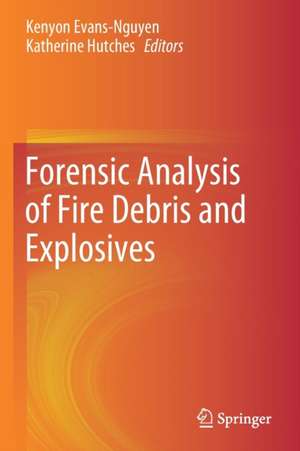Forensic Analysis of Fire Debris and Explosives
Editat de Kenyon Evans-Nguyen, Katherine Hutchesen Limba Engleză Paperback – 18 oct 2020
| Toate formatele și edițiile | Preț | Express |
|---|---|---|
| Paperback (1) | 458.61 lei 6-8 săpt. | |
| Springer International Publishing – 18 oct 2020 | 458.61 lei 6-8 săpt. | |
| Hardback (1) | 525.87 lei 3-5 săpt. | +29.34 lei 5-11 zile |
| Springer International Publishing – 18 oct 2019 | 525.87 lei 3-5 săpt. | +29.34 lei 5-11 zile |
Preț: 458.61 lei
Nou
Puncte Express: 688
Preț estimativ în valută:
87.77€ • 91.29$ • 72.46£
87.77€ • 91.29$ • 72.46£
Carte tipărită la comandă
Livrare economică 14-28 aprilie
Preluare comenzi: 021 569.72.76
Specificații
ISBN-13: 9783030258368
ISBN-10: 303025836X
Pagini: 356
Ilustrații: VIII, 356 p. 193 illus., 101 illus. in color.
Dimensiuni: 155 x 235 mm
Greutate: 0.51 kg
Ediția:1st ed. 2019
Editura: Springer International Publishing
Colecția Springer
Locul publicării:Cham, Switzerland
ISBN-10: 303025836X
Pagini: 356
Ilustrații: VIII, 356 p. 193 illus., 101 illus. in color.
Dimensiuni: 155 x 235 mm
Greutate: 0.51 kg
Ediția:1st ed. 2019
Editura: Springer International Publishing
Colecția Springer
Locul publicării:Cham, Switzerland
Cuprins
1. Introduction to instrumentation used in FD/E analysis (Kenyon Evans-Nguyen, Associate Professor, University of Tampa).- 2. Fire debris analysis: general introduction to how it is currently done (Mark Sandercock, Team Lead - Trace Evidence, Royal Canadian Mounted Police).- 3. Microbial degradation of ignitable liquids (Katherine Hutches, Forensic Chemist, Bureau of Alcohol, Tobacco, Firearms and Explosives).- 4. Background interferences in fire debris analysis (Jamie Baerncopf and Sherrie Thomas, Forensic Chemists, Bureau of Alcohol, Tobacco, Firearms and Explosives).- 5. Alternative Fuels: E85, biodiesel, vegetable oils, etc. (Doug Byron, Forensic & Scientific Testing, Inc and Raymond Kuk, Section Chief, Bureau of Alcohol, Tobacco, Firearms and Explosives).- 6. Variation in gasoline/general IL variation within classes (Susan Hetzel, Senior Analytical Chemist, SEA Limited and Mary Williams, Coordinator of Research Programs & Services, National Center forForensic Science, University of Central Florida).- 7. Explosives analysis: general introduction to intact analysis of explosives (Hazel Hutson, Principal Case Officer, Defence Science and Technology Laboratory and Eamonn McGee, Senior Forensic Technologist, Centre of Forensic Sciences).- 8. Explosives analysis: introduction to post-blast analysis (Brittany Crane-Calhoun, Forensic Chemist, Bureau of Alcohol, Tobacco, Firearms and Explosives and Robert Mothershead II, Supervisory Chemist - Forensic Examiner, Federal Bureau of Investigation).- 9. Componentry (Kirk Yeager and Kathy Boyle, Forensic Chemists, Bureau of Alcohol, Tobacco, Firearms and Explosives).- 10. Battlefield Forensics (James Garcia, Head of Trace Analysis and Chemistry, Defense Forensic Science Center and Robert Ollis, Forensic Chemist, Defense Forensic Science Center).- 11. Fire debris/explosives overlap: flares/fusees, thermite, ANFO (Michelle Evans, Forensic Chemist, Bureau of Alcohol, Tobacco, Firearms and Explosives).- Index.
Notă biografică
Kenyon Evans-Nguyen is Associate Professor of Chemistry at the University of Tampa. He specializes in the development of new methods for detection of controlled substances in toxicology analyses and is interested in the application of mass spectrometry and analytical chemistry to forensic science.
Katherine Hutches is a Forensic Chemist at the United States Bureau of Alcohol, Tobacco, Firearms and Explosives. She specializes in analytical chemistry and has published a number of articles involving the use of analytical chemistry in forensics.
Textul de pe ultima copertă
This text provides training on the fundamental tools and methodologies used in active forensic laboratories for the complicated analysis of fire debris and explosives evidence. It is intended to serve as a gateway for students and transitioning forensic science or chemistry professionals. The book is divided between the two disciplines of fire debris and explosives, with a final pair of chapters devoted to the interplay between the two disciplines and with other disciplines, such as DNA and fingerprint analysis. It brings together a multi-national group of technical experts, ranging from academic researchers to active practitioners, including members of some of the premier forensic agencies of the world. Readers will gain knowledge of practical methods of analysis and will develop a strong foundation for laboratory work in forensic chemistry. End-of-chapter questions based on relevant topics and real-world data provide a realistic arena for learners to test newly-acquired techniques.
Caracteristici
Features a practical, hands-on approach suitable for classroom use and professional training by forensic agencies Covers complications introduced by environmental factors such as microbial degradation of ignitable liquids and background interferences Discusses evidence that does not fall neatly into one category or another, such as road flares or mixtures of ammonium nitrate/fuel oil (ANFO) Includes end-of-chapter questions based on real-world data to prepare readers for a forensics laboratory career
